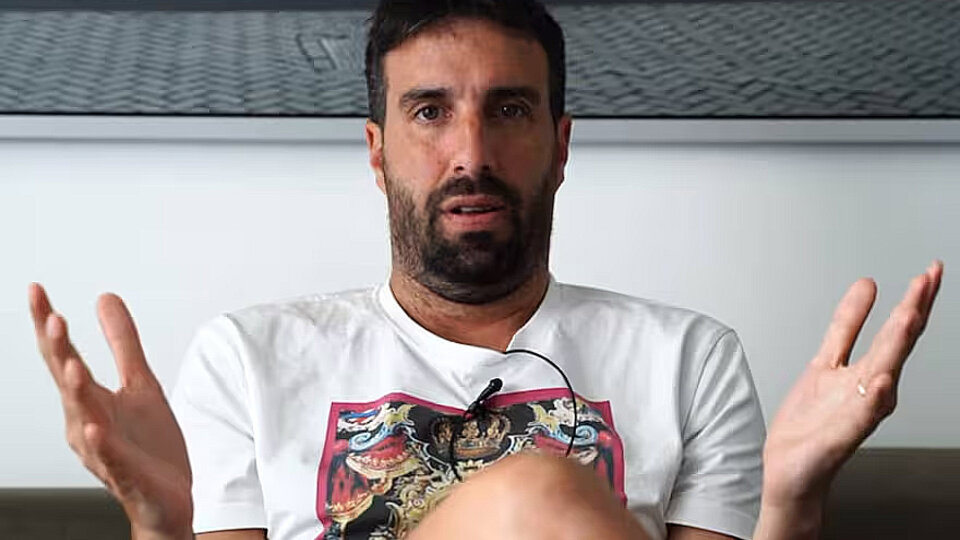A few hours ago, Flavio Azzaro returned from San Pablo, where he covered the first leg of the South American Cup semifinals between Racing, are Racing, and Corinthians. His face retains the smile left by the valuable away draw but above all, the team’s performance. The interview could have been somewhere else, but he proposed Avellaneda.
More than a YouTuber or a streamer, Azzaro is actually the owner of a rapidly growing SME in the audiovisual sector and, probably, one of those who best represents and understands this new wave, which he considers democratizing communication and which is also driven by an alleged lack of interest among young people in watching traditional television.
His digital channel already employs twenty people (“a large field team and a bench of substitutes,” he jokes) and although everyone refers to him with “El loco y el sane,” which has been breaking audience records for two years, he is already producing seven programs and going for more. Next year he will have four complete studios, he says, to continue increasing the stakes.
Azzaro speaks, gestures, the conversation at times becomes too choppy, between the requests for photos from his followers, which he accepts without hesitation, and the attention that his phone demands, leaning on the table in a bar near the Cilindro, the stadium. President Perón, his place in the world.
When Azzaro gains confidence, he is nothing like the character he creates in front of the camera, which allowed him to generate countless controversies and a community of more than half a million followers, as he says, “almost all young men, between 24 and 45, with political concerns.” He is a kind, simple guy, from the neighborhood, from a working background (his father is Oscar, an architect, and his mother Carmen, a merchant), from Avellaneda. “My mother has had a kiosk for 35 years, my business side comes from there,” he confesses.
–Does streaming democratize communication? Are there more opportunities for people who otherwise would never have entered the medium?
–Before, to start working as a journalist, you had two ways: in small neighborhood media, paying for space, or falling into free or poorly paid internships, which the media used to spend less and not to train communicators. In this case, the saying “every time in the past was better” does not apply. Today a kid does not need the structures of the hegemonic media to be a journalist. You need, neither more nor less, to be good at what you do. Say things that interest you. There are hundreds of kids who have channels on YouTube, Instagram or Twitter accounts and do self-managed journalism. Without having to give in to line drops from traditional channels. Today there are other, much more interesting options.
–How much strategy and how much improvisation was there in your growth?
–The key, in my view, or, rather, what worked for me, is the mixture of everything. Improvisation, planning and, essentially, a lot of passion. I was always passionate about the things I decided to do. From my beginnings in Identidad Racinguista, my first appearances in the Football Show, hosting Fútbol Al Horno… I always did everything with a lot of passion and commitment.
–How did you start streaming? What did you discover?
–From the first moment I decided to start withdrawing from traditional media, I began to dedicate time, mind and study to the world of YouTube. I realized that I couldn’t work in media companies anymore. That he was no longer happy. That he couldn’t say everything he wanted. Then I started investing fully in the YouTube channel. To upload more and more content, to professionalize it each time, to add more and more people. To buy better equipment. I took a risk. Without risks, there is no success. And no pain, either.
–What do you think is going to happen to traditional media in ten or twenty years? Are they going to cease to exist? Are they going to occupy different niches?
–No, not to cease to exist. I still have many friends who continue to work in that world, so I don’t wish them anything bad, for their sake I wouldn’t want traditional media to become extinct. Many people would be left without jobs, more than there are already, because there is still no place for everyone in modern media. What is going to happen is that they will have less and less audience. Audience fragmentation is already a fact. That sooner or later will make brands invest less and governments will also begin to diversify their guidelines. From the point of view of return on advertising investment, digital media wins by a lot, advertisers already understood that. That is why they are going to have increasing financing problems.
–Are other aspects also involved or is it all commercial?
–There is the question of credibility. Kids don’t watch TV anymore. Not only because they are more linked to the cell phone or the play, but because we, those under 45, in many cases parents of those kids, no longer believe in TV and we pass that feeling on to the younger ones. Kirchnerism was key for us to start distrusting the traditional media. Never before has a government been so eloquent. Those of my generation distrust traditional media. The kids grew up with this distrust towards the big media. That is why I believe that the market will continue to shrink in traditional media and will begin to shift to other communication channels.
–What is the relationship with the public like in the world of YouTube? Is it different from television? What benefits does it have?
–The public is more grateful in streaming. People know that there are no resources here like on TV. He supports you, guides you, encourages you. Of course there are also jokes, of course, but the streaming audience feels part of the content, they get involved, that’s where the concept of community comes from. As an example, in 2022 people paid the fare for two of my editors so that we could cover the World Cup in Qatar.
–How was that?
–I explained to them that in order to give them coverage like what they demanded, we needed more structure. That my wife and I alone, as we had started, were not going to be able to give them what they asked for. And the same followers financed much of the stay of two editors. That’s impossible to happen on TV. Can you imagine people putting up money for Vignolo and “Chavo” Fucks to travel? Impossible. YouTube is people. It’s community. People know that there is no State money here and that, only now, the big brands are arriving, that’s why they bank us


